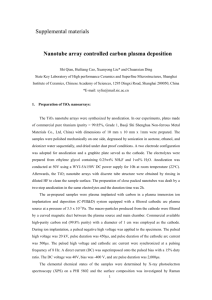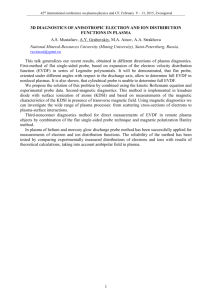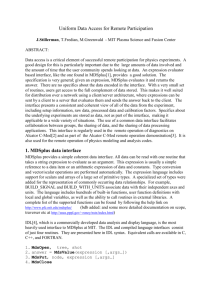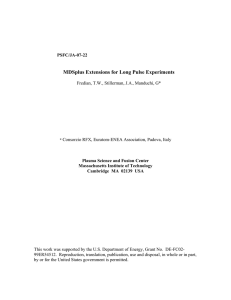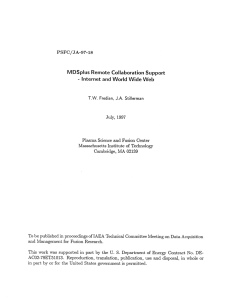- Australian National University
advertisement
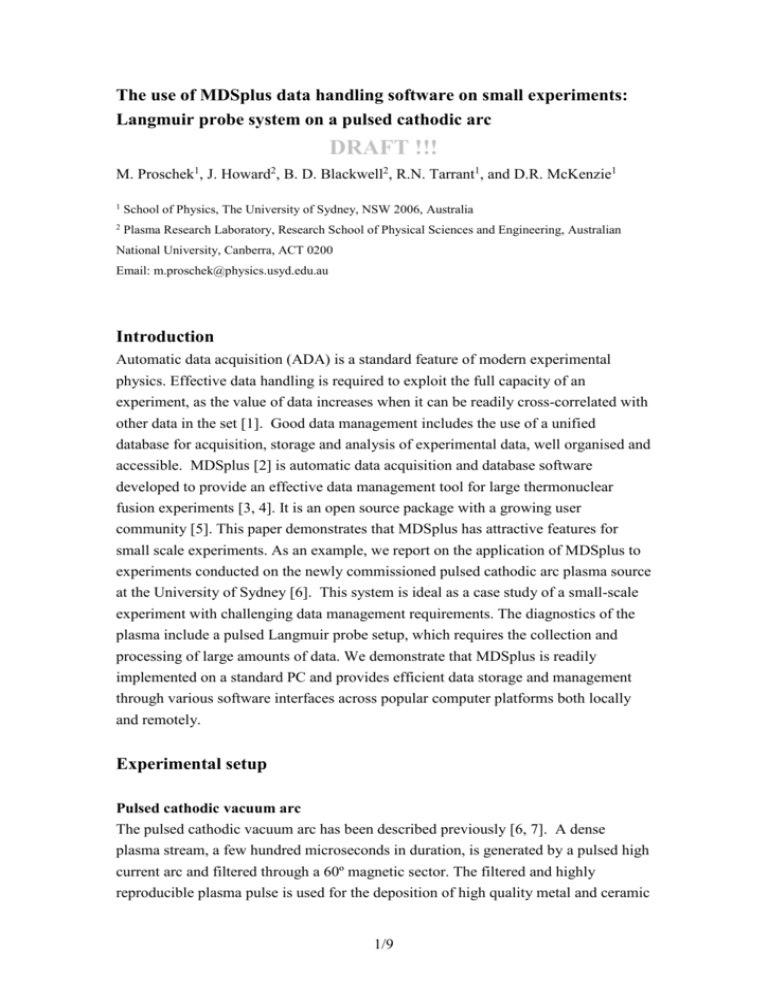
The use of MDSplus data handling software on small experiments: Langmuir probe system on a pulsed cathodic arc DRAFT !!! M. Proschek1, J. Howard2, B. D. Blackwell2, R.N. Tarrant1, and D.R. McKenzie1 1 School of Physics, The University of Sydney, NSW 2006, Australia 2 Plasma Research Laboratory, Research School of Physical Sciences and Engineering, Australian National University, Canberra, ACT 0200 Email: m.proschek@physics.usyd.edu.au Introduction Automatic data acquisition (ADA) is a standard feature of modern experimental physics. Effective data handling is required to exploit the full capacity of an experiment, as the value of data increases when it can be readily cross-correlated with other data in the set [1]. Good data management includes the use of a unified database for acquisition, storage and analysis of experimental data, well organised and accessible. MDSplus [2] is automatic data acquisition and database software developed to provide an effective data management tool for large thermonuclear fusion experiments [3, 4]. It is an open source package with a growing user community [5]. This paper demonstrates that MDSplus has attractive features for small scale experiments. As an example, we report on the application of MDSplus to experiments conducted on the newly commissioned pulsed cathodic arc plasma source at the University of Sydney [6]. This system is ideal as a case study of a small-scale experiment with challenging data management requirements. The diagnostics of the plasma include a pulsed Langmuir probe setup, which requires the collection and processing of large amounts of data. We demonstrate that MDSplus is readily implemented on a standard PC and provides efficient data storage and management through various software interfaces across popular computer platforms both locally and remotely. Experimental setup Pulsed cathodic vacuum arc The pulsed cathodic vacuum arc has been described previously [6, 7]. A dense plasma stream, a few hundred microseconds in duration, is generated by a pulsed high current arc and filtered through a 60º magnetic sector. The filtered and highly reproducible plasma pulse is used for the deposition of high quality metal and ceramic 1/9 multi-layer films [Luke’s Conference paper]. The system may be operated at repetition rates of up to 30 Hz, and deposition rates of up to 0.3 nm/pulse. The vacuum vessel used for the pulsed arc provides excellent access for a range of diagnostics for the study of the transport of the high density arc plasma. Data acquisition and data base system A feature of MDSplus is its integral remote data access, which simplifies data exchange with our collaborators from the H1-team [4] at the ANU. Furthermore, data structures (data-trees) from diagnostics, developed at the ANU site, can directly be linked into the pulsed arc data-tree. An ADA system consisting of digital storage oscilloscopes and LabView control software had already been installed before the implementation of MDSplus was considered. In the existing system, data from the oscilloscopes were downloaded via a GPIB (general purpose instrument bus) and the data stored to ASCII files. We were able to install MDSplus without having to change the existing ADA hardware (Figure 1). All that was required was minor modification of the LabView codes, so that the recorded signals are saved into a well structured database rather than into individual ASCII files. The use of MDSplus subroutines written by J. Howard [#], which are based on the LabView code from the MDSplus distribution [#], made it relatively easy to implement these changes. Furthermore, the data from different experimental configuration files, including information such as installed cathode material, power supply timing and the total number of pulses over the lifetime of the cathode, is now saved into the model-pulse files [#] of the data base. This has the advantage that the system configuration at the time of each pulse is saved with its data set. A set of standard signals are recorded and saved with each measurement. These include the time traces of anode, cathode and duct currents and the substrate bias. The background vacuum pressure and the pressure immediately after a pulse are also recorded each time, as well as comments and probe location. These signals can be seen in Figure 2, which is a screen shot of the convenient data display tool “JScope” [#]. For data safety we decided to use a data server independent of the ADA PC. A Linux server (as part of the LAN) was chosen, as automatic back-up, IDL and X-Window access is supported. 2/9 TRIGGER timer PCI - card Digital Oscilloscopes GPIB ADC PCI - card PCI SIGNALS PCI A B ADA PC (WinXP) data server PC (Linux) LabView MDSplus ETHERNET backup C data display and analysis PC (Linux, Mac or Windows) Figure 1. Schematic of the pulsed arc data acquisition system. Figure 1 shows a schematic of the ADA system used for data acquisition and storage. The ADA computer (A in Figure 1) runs a set of LabView programs which control the experiment (e.g. triggering, setting probe voltage), acquire the slower signals through an ADC-card (PCI) and download the acquired oscilloscope data via a GPIB. Furthermore these signals and other information are stored into the data-tree of a local MDSplus installation and, if the LAN is working, are also transferred to the MDSplus data server (B). Any computer of the workgroup (C), having a local MDSplus installation or X-Window access, can read the data from all recorded pulses and write back results from analysis. At this stage, we only use the data base functionality of MDSplus, but it is planned to upgrade the ADA system with PCI based high speed digitizers [8], which will communicate directly with MDSplus. 3/9 Figure 2. Screen shot of “JScope” displaying same standard signals on the left and probe traces on the right for pulsed_arc #10873. Pulsed Langmuir probe The single Langmuir probe is manually moveable in one dimension though a ¼” Oring sealed feedthrough. The probe head consists of a 0.2 mm diameter W-wire inside a 3 mm diameter ceramic tube. Three millimetres of the W-wire is exposed to the plasma. The bias voltage of the probe is software controlled using an analogue output channel of a standard PCI ADA card, in conjunction with an amplifier, which is part of a Langmuir probe driver unit. This unit also includes current and voltage sensing electronics. Due to the short pulse length of the arc discharge, typically a few hundred microseconds, sweeping of the probe voltage in the normal manner is not possible. Making use of the high reproducibility of the arc plasma a time-resolved measurement was achieved by combining data from many individual pulses. By stepping the probe Voltage (V) from one pulse to the next and recording the time evolution of probe current (I) and Voltage each pulse, a large set of I/V curves over the lifetime of the arc plasma was acquired and subsequently analyzed. To reduce the influence from fluctuations and noise every individual measurement was an average over 16 pulses. In order to obtain profiles across the plasma beam, the probe was stepped through a number of positions. 4/9 The large number of individual measurements (millions of data points) makes automatic data acquisition essential and the use of a data management tool advisable. For each recorded pulse all the relevant information about the machine and the probe traces are stored in the data base and can be accessed from the analysis software. A LabView program automatically steps through a given voltage range (typically -50 to +50 V, in 2V increments); it automatically sets the probe voltage, triggers the pulsed arc, acquires selected signals, writes the data to the data base and then proceeds to the next probe voltage. At the moment a typical scan takes in the order of 10 minutes; PCI based high speed digitisers would speed up the scan time to less than a minute. Data analysis The subroutines for read and write access to the MDSplus database in IDL is part of the MDSplus software release, and are straightforward to use even for an IDL beginner. Consequently, the alteration of an existing Langmuir probe analysis code was not very time consuming (about a week). Figure 3 shows a screen shot of the IDL analysis program “probe_wid”. The window in focus is the entry window for the MDSplus data access, where the pulse range of the set of measurements for a probe scan is selected. It illustrates the hierarchical tree structure - in the shown case the two nodes V_PROBE and I_PROBE_CAL (located in the branch PROBES.SIMPLE) will be loaded from the data tree PULSED_ARC for all pulses from 10446 to 10456. It will be accessed from the server alektryon through port 8000. 5/9 Figure 3. Screen shot of the interactive IDL analysis program (probe_wid). The window in focus Some results The aim of the probe measurements was to help to understand the plasma transport of the newly commissioned pulsed cathodic arc. A detailed discussion of the results can be found elsewhere [##]. In the background window of the screen shot (Figure 3) a typical IV-curve for a single time step can be seen. The linear fit of the ion saturation (dashed line) and electron saturation region (solid straight line) and the exponential electron temperature fit are overlaid. For a typical IV-scan of the probe at a single location information from typically 500 pulses is analysed. Most plasma fluctuations will therefore be averaged out, and this method only gives an average time evolution. However, surprisingly detailed information can be obtained, which is demonstrated in Figure 4, where the results from the first 100 s of the arc discharge are plotted. The peak stemming from the trigger spark can be clearly seen in the ion density plot at around 18 s. At 30 s, 6/9 after the arc has been initiated, an initial burst of electrons clearly pulls the floating potential down to high negative values. 19 2 10 19 1.5 10 19 1 10 19 5 10 18 3 n ion [1/m ] 2.5 10 3 ion density [1/m ] 0 16 electron temperature [eV] Te [eV] 14 12 10 8 6 -30 V float [V] -35 -40 -45 -50 -55 floating potential [V] -60 -65 0 0.02 0.04 0.06 0.08 0.1 time [ms] Figure 4. Ion density, electron temperature and floating potential of the arc plasma during the first 100 s of the arc discharge. The peak at 18 s in the ion density stems from the trigger spark. CONCLUSION Experience with MDSplus Basically the entire infrastructure needed for installing MDSplus is available in a typical research environment (local Ethernet, workstations). It was possible for an untrained Linux user to install the system on a standard Linux RedHat 9.0 workstation, with the provided online help (www.mdsplus.org). With each pulse a lot of information is stored, which would not be recorded otherwise. This includes the standard arc current traces, machine configuration (e.g. cathode material) and vacuum background pressure. The data is stored efficiently and we collected for the first 1000 pulses about 250 Mbytes of data, which is a small fraction of the available disc space. We expect the amount of data to grow 7/9 significantly with the installation of additional diagnostics, which poses no problem due to the availability of cheap hard disc space. Benefits: Collaboration, remote access No time stamp problem ( unlike Windows files; especially distributed file systems) No unorganized ASCII-files fully integrated data analysis (IDL) LabView interface available flexibility of adding a signal to the data tree all parameters are recorded for later analysis data mining convenient Display tool available free – open source future development Probe measurements The reproducibility of the experimental conditions is a prerequisite for the pulse to pulse technique. The success of the data analysis clearly shows that this is satisfied. ….. References 1. 2. 3. 4. 5. 6. 7. Howa, J.A., J.W. Farthing, and V. Schmidt, Trends in computing systems for large fusion experiments. Fusion Engineering and Design, 2004. 70(2): p. 115122. A.Stillerman, J., et al., MDSplus data acquisition system. Review of Scientific Instruments, 1997. 68(1): p. 939-42. Davis, W., et al., The use of MDSplus on NSTX at PPPL. Fusion Engineering and Design, 2002. 60(3): p. 247-251. Blackwell, B.D., et al., Overview and results from the H-l National Facility. AIP. American Institute of Physics Conference Proceedings, 2003(669): p. 158-61. Fredian, T.W. and J.A. Stillerman, MDSplus. Current developments and future directions. Fusion Engineering & Design, 2002. 60(3): p. 229-33. T.W.H.Oates, et al., A high-current pulsed cathodic vacuum arc plasma source. Review of Scientific Instruments, 2003. 74(11): p. 4750-4754. R.N.Tarrant, et al., Plasma transport and optical flares in high-density plasmas produced from a pulsed cathodic arc. Surface and Coatings Technology, 2004 (in press). 8/9 8. Stillerman, J.A. and T.W. Fredian, CompactPCI based data acquisition with MDSplus. Elsevier. Fusion Engineering & Design, 2002. 60(3): p. 241-5. 9/9


